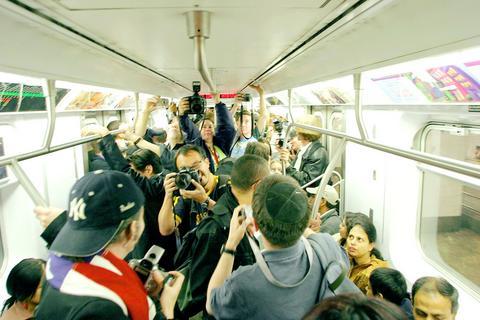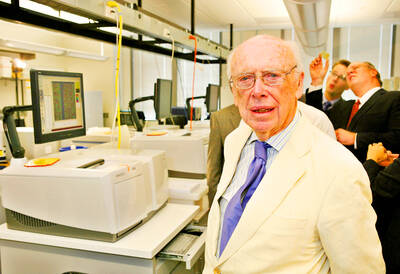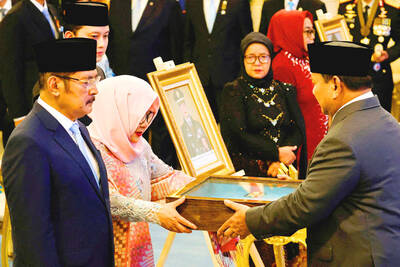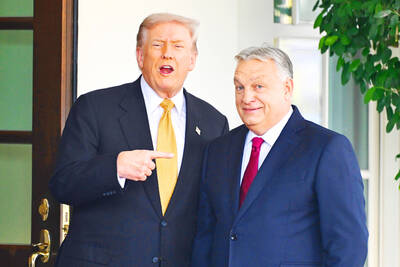At a protest by photographers, you see things like a guy taking pictures of a guy taking pictures of a few more guys taking pictures of each other. There was such a protest on Sunday, but it might take hundreds of pages to describe it, given all the pictures that were taken, each one worth at least a thousand words.
The photographers -- about 100 of them -- gathered to express their outrage at the Metropolitan Transportation Authority's proposed ban on taking pictures in the subway system.

PHOTO: NY TIMES NEWS SERVICE
Meeting at Grand Central Terminal, they rode the trains for upward of an hour, shutters clicking, flashes popping, in a filmed rebuke to the idea that photography is somehow a national security threat.
"The point is really to make everyday people wake up and realize that photographers are not terrorists," said Joe Anastasio, who organized the event. "In the last few years, photographers near anything vaguely important have been getting harassed."
Anastasio went on to tell the story of a friend who took his wife's picture near the Whitestone Bridge, only to be called in for questioning by the police. He told another of a man caught snapping pictures at a Metro-North station who was interrogated for nearly two hours by authorities at the scene.
"The paranoia," he said, "has gone a little too far."
The transit authority's proposal, posted on its Web site, says the agency is planning to adopt "a general prohibition against photography and videotaping in the system." The agency is soliciting public comment on the ban and plans to vote on the proposal in the next few months.
"It's a security measure," said a spokeswoman for the agency, Deirdre Parker. "It was suggested by the NYPD."
Anastasio and his fellow photographers said it was ridiculous that pictures of the subway might somehow make the trains unsafe. After all, they said, there are thousands of subway photographs already on the Internet.
"The subway is so well documented that what's the point?" asked Jean Miele, a fine art and commercial photographer. "This sort of thing makes us less free, not safer."
Infuriated that his photographic rights might in fact be curtailed, Anastasio sent messages to several friends, asking them to show up on Sunday to photograph the subway. They did -- with Nikons, Leicas, Canons and such.
There were an US$8,000 digital job and a cheap mini that showed a nudie picture through its viewfinder.
When a downtown No. 6 train arrived, the photographers began to cheer. They boarded in a herd and held their cameras up, taking pictures of other hands holding cameras up.
At the 14th Street station, they split into two groups, stood against the walls and photographed each other across a corridor.
There was a tense moment when the crowd decided it would photograph a transit police dispatch station at 14th Street. A startled officer came out and suggested that they leave.
"You didn't say `Cheese!"' one of the cheekier photographers said.
Many of the photographers said they planned to post their pictures on the Internet -- Jared Skolnick, for example, who takes pictures of the subway on his cellphone and then displays them online.
"I've learned that so many crazy things can happen on the subway," said Skolnick, who paused and then added, "including this."

James Watson — the Nobel laureate co-credited with the pivotal discovery of DNA’s double-helix structure, but whose career was later tainted by his repeated racist remarks — has died, his former lab said on Friday. He was 97. The eminent biologist died on Thursday in hospice care on Long Island in New York, announced the Cold Spring Harbor Laboratory, where he was based for much of his career. Watson became among the 20th century’s most storied scientists for his 1953 breakthrough discovery of the double helix with researcher partner Francis Crick. Along with Crick and Maurice Wilkins, he shared the

OUTRAGE: The former strongman was accused of corruption and responsibility for the killings of hundreds of thousands of political opponents during his time in office Indonesia yesterday awarded the title of national hero to late president Suharto, provoking outrage from rights groups who said the move was an attempt to whitewash decades of human rights abuses and corruption that took place during his 32 years in power. Suharto was a US ally during the Cold War who presided over decades of authoritarian rule, during which up to 1 million political opponents were killed, until he was toppled by protests in 1998. He was one of 10 people recognized by Indonesian President Prabowo Subianto in a televised ceremony held at the presidential palace in Jakarta to mark National

US President Donald Trump handed Hungarian Prime Minister Viktor Orban a one-year exemption from sanctions for buying Russian oil and gas after the close right-wing allies held a chummy White House meeting on Friday. Trump slapped sanctions on Moscow’s two largest oil companies last month after losing patience with Russian President Vladimir Putin over his refusal to end the nearly four-year-old invasion of Ukraine. However, while Trump has pushed other European countries to stop buying oil that he says funds Moscow’s war machine, Orban used his first trip to the White House since Trump’s return to power to push for

LANDMARK: After first meeting Trump in Riyadh in May, al-Sharaa’s visit to the White House today would be the first by a Syrian leader since the country’s independence Syrian President Ahmed al-Sharaa arrived in the US on Saturday for a landmark official visit, his country’s state news agency SANA reported, a day after Washington removed him from a terrorism blacklist. Sharaa, whose rebel forces ousted long-time former Syrian president Bashar al-Assad late last year, is due to meet US President Donald Trump at the White House today. It is the first such visit by a Syrian president since the country’s independence in 1946, according to analysts. The interim leader met Trump for the first time in Riyadh during the US president’s regional tour in May. US envoy to Syria Tom Barrack earlier